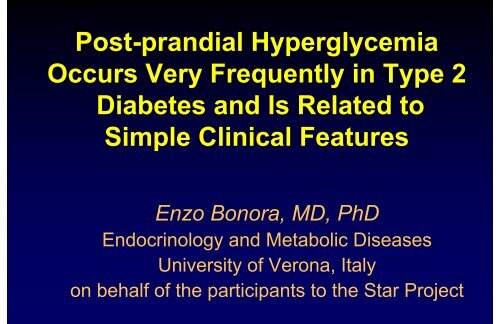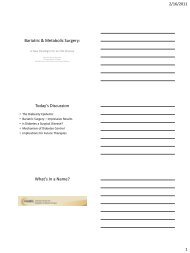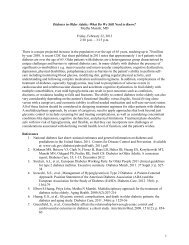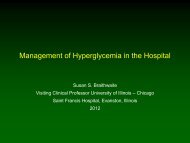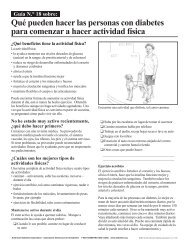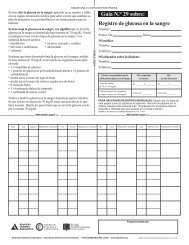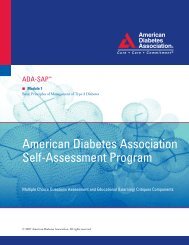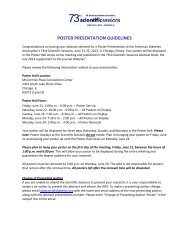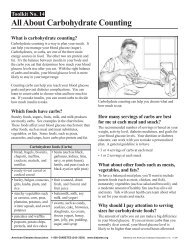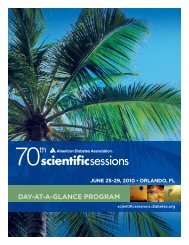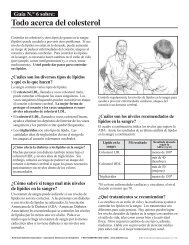Postprandial Hyperglycemia Occurs Very Frequently in Type 2 ...
Postprandial Hyperglycemia Occurs Very Frequently in Type 2 ...
Postprandial Hyperglycemia Occurs Very Frequently in Type 2 ...
You also want an ePaper? Increase the reach of your titles
YUMPU automatically turns print PDFs into web optimized ePapers that Google loves.
Post-prandial <strong>Hyperglycemia</strong><br />
<strong>Occurs</strong> <strong>Very</strong> <strong>Frequently</strong> <strong>in</strong> <strong>Type</strong> 2<br />
Diabetes and Is Related to<br />
Simple Cl<strong>in</strong>ical Features<br />
Enzo Bonora, MD, PhD<br />
Endocr<strong>in</strong>ology and Metabolic Diseases<br />
University of Verona, Italy<br />
on behalf of the participants to the Star Project
Introduction<br />
‣ Post-prandial hyperglicemia significantly<br />
contributes to HbA1c concentrations<br />
‣ Post-prandial hyperglicemia significantly<br />
contributes to the development of CVD and<br />
other chronic complications of diabetes<br />
‣ A specific target for post-prandial glycemia has<br />
been <strong>in</strong>dicated by several scientific societies<br />
and expert panels
Aim of the Study<br />
‣ To establish how often post-prandial<br />
hyperglycemia does occur <strong>in</strong> type 2<br />
diabetes<br />
‣ To identify which cl<strong>in</strong>ical features are<br />
associated to post-prandial hyperglycemia<br />
and might predict it
Subjects<br />
6009 type 2 diabetic patients<br />
500 diabetes cl<strong>in</strong>ics <strong>in</strong> Italy<br />
No <strong>in</strong>sul<strong>in</strong> treatment<br />
Stable diet, physical activity and treatment<br />
No recent acute illness or major co-morbidity<br />
Home blood glucose monitor<strong>in</strong>g: 3 daily<br />
glucose profiles <strong>in</strong>clud<strong>in</strong>g read<strong>in</strong>gs before and<br />
2 h after the 3 meals<br />
3284 patients provided complete data:<br />
18 read<strong>in</strong>gs, 9 meals monitored
Methods<br />
‣ HBGM (Euroflash, Lifescan)<br />
‣ HbA1c (DCCT calibrated)<br />
‣ Plasma lipids<br />
‣ BMI<br />
‣ Blood pressure<br />
‣ Treatment<br />
Post-prandial hyperglycemia = >160 mg/dl<br />
Post-prandial peak =<br />
∆≥ 40 mg/dl<br />
∆ % ≥ 25
Ma<strong>in</strong> Cl<strong>in</strong>ical Features<br />
Male sex (%)<br />
Age (yr)<br />
BMI (kg/m 2 )<br />
Duration (yr)<br />
Fast<strong>in</strong>g glucose (mg/dl)<br />
HbA1c (%)<br />
Total cholesterol (mg/dl)<br />
HDL-cholesterol (mg/dl)<br />
Triglycerides (mg/dl)<br />
Systolic blood pressure (mmHg)<br />
Diastolic blood pressure (mmHg)<br />
Oral agents (%)<br />
51<br />
63 ± 10<br />
28.7 ± 4.6<br />
8.4 ± 7.6<br />
155 ± 44<br />
7.47 ± 1.45<br />
204 ± 38<br />
47 ± 14<br />
149 ± 64<br />
139 ± 16<br />
81 ± 9<br />
87.3
Mean Daily Blood Glucose Profile<br />
<strong>in</strong> 3284 Non-Insul<strong>in</strong>-Treated Patients with T2DM<br />
200<br />
Blood glucose (mg/dl)<br />
150<br />
142<br />
161<br />
137<br />
172<br />
136<br />
172<br />
100<br />
Before After Before After Before After<br />
Breakfast Lunch D<strong>in</strong>ner
Mean <strong>Postprandial</strong> Blood Glucose Increase<br />
<strong>in</strong> 3284 Non-Insul<strong>in</strong>-Treated Patients with T2DM<br />
35<br />
30<br />
30<br />
25<br />
∆ (mg/dl)<br />
25<br />
20<br />
15<br />
10<br />
∆ (%)<br />
20<br />
15<br />
10<br />
5<br />
5<br />
0<br />
B L D<br />
0<br />
B L D<br />
Absolute <strong>in</strong>crease<br />
Relative <strong>in</strong>crease
Frequency of <strong>Postprandial</strong> Peaks <strong>in</strong> T2DM<br />
%<br />
40<br />
35<br />
30<br />
25<br />
20<br />
15<br />
10<br />
5<br />
0<br />
All<br />
HbA1c 40 mg/dl.
Proportion of non-<strong>in</strong>sul<strong>in</strong>-treated patients with<br />
T2DM with exaggerated glucose levels or<br />
glucose excursions follow<strong>in</strong>g the meals<br />
60<br />
All HbA1c 160 mg/dl<br />
At least 30% of postprandial<br />
glucose excursions >40 mg/dl
Glucose change after meal accord<strong>in</strong>g to<br />
preprandial glucose<br />
35<br />
30<br />
p
Glucose change after meal accord<strong>in</strong>g to<br />
35<br />
age and duration of diabetes<br />
∆ glucose (mg/dl)<br />
30<br />
25<br />
20<br />
15<br />
10<br />
5<br />
P
Glucose change after meal accord<strong>in</strong>g to<br />
the features of the Metabolic Syndrome<br />
35<br />
30<br />
∆ glucose (mg/dl)<br />
25<br />
20<br />
15<br />
10<br />
P
35<br />
Glucose change after meal accord<strong>in</strong>g<br />
to diabetes treatment<br />
∆ glucose (mg/dl)<br />
30<br />
25<br />
20<br />
15<br />
10<br />
5<br />
0<br />
Diet Met SU Met+SU Other<br />
Overall<br />
p
Multivariate analysis<br />
Factors <strong>in</strong>dependently related to excessive<br />
glucose change after meal:<br />
• pre-prandial glucose (<strong>in</strong>verse; p
Conclusions<br />
‣ Post-prandiale hyperglycemia is a very<br />
frequent phenomenon <strong>in</strong> patients with<br />
type 2 diabetes on active treatment<br />
‣ Post-prandiale hyperglycemia does<br />
occur also when the metabolic control is<br />
apparently good<br />
‣ Post-prandial hyperglycemia can be<br />
predicted by simple cl<strong>in</strong>ical features (preprandial<br />
glycemia, age, duration of<br />
diabetes, BMI, hypertension, treatment)


